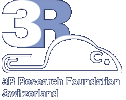 |
de | fr | en print view![]()
3R-Project 46-96
Development and Validation of an In Vitro Model Simulating Mechanical Ventilation-Induced Inflammation
Jérôme Pugin
Division des Soins Intensifs de Médecine, Hôpital Cantonal Universitaire, 1211 Genève 14, Switzerland
pugin@cmu.unige.ch
Keywords: lung; cytokines, growth factors; inflammation; cell cultures: organ-specific; reduction
Duration: 3 years Project Completion: 2000
Background and Aim
Critically ill patients with sepsis and adult respiratory distress syndrome (ARDS) are frequently submitted to prolonged positive pressure mechanical ventilation (MV) to prevent pulmonary failure. It has recently been recognized that MV per se can induce significant lung injury. Evidence for this arises mainly from animal studies. This project was designed to develop an in vitro model to study MV-induced lung inflammation. In this model, lung cells were submitted to a prolonged cyclic pressure-stretching strain resembling that of conventional MV.
Method and Results
Primary human lung cells or cell lines were cultured on a stretchable silastic membrane forming the bottom of a 12-well plexiglas® box. The box was connected to an adult ventilator and "ventilated" for up to 36 hours at 20 cycles/min with a pressure-volume regimen resembling that of MV. Several lung cell types were tested in this model. The alveolar macrophage was identified as the main cellular source of key inflammatory mediators, such as tumor necrosis factor, the chemokine interleukin (IL)-8, and matrix metalloproteinase-9, produced during mechanical ventilation. Mechanical ventilation also induced low levels of IL-8 secretion by human alveolar epithelial type II-like cells. Other lung cell types such as endothelial cells, bronchial cells, and fibroblasts failed to produce IL-8 in response to mechanical ventilation (1,2).
Conclusions and Relevance for 3R
The described in vitro model provides mechanistic information at the molecular and cellular levels for the lung inflammation observed during mechanical ventilation of patients. It allows mechanical stress-induced signaling pathways to be explored without the use of animal models, and permits the testing of novel ventilatory strategies and adjunctive substances aimed at modulating cell activation induced by mechanical ventilation.
References
1. Pugin J, Dunn I, Jolliet P, Tassaux D, Magnenat JL, Nicod LP, Chevrolet JC. Activation of human macrophages by mechanical ventilation in vitro. Am J Physiol 1998; 275:L1040-50.
2. Dunn I, Pugin J. Mechanical ventilation of various human lung cells in vitro: identification of the macrophage as the main producer of inflammatory mediators. Chest 1999; 116:95S-97S.
3. Pugin J, Jolliet P. Ventilator-induced lung injury: an inflammatory disease ? Clin Pulm Med 1998; 290-299.
4. Oudin S, Pugin J. Signaling pathways activated by cyclic stretch in human bronchial epithelial cells. Abstract submitted to the American Thoracic Society, manuscrit en cours de rédaction.
5. Hribar M, Bloc A, van der Goot FG, Fransen L, de Baetselier P, Grau GE, Bluethmann H, Matthay MA, Dunant Y, Pugin J, Lucas R. The lectin-like domain of tumor necrosis factor-alpha increases membrane conductance in microvascular endothelial cells and peritoneal macrophages. Eur J Immunol 1999; 10:3105-3111.
6. van der Goot FG, Pugin J, Hribar M, Fransen L, Dunant Y, de Baetselier P, Bloc A, Lucas R. Membrane insertion of TNF is not sufficient to trigger increase in membrane conductance in mammalian cells. FEBS letter, 1999; 460: 107-11.
7. Farmer P, Pugin J. Implication of the NF-kappa B pathway in the anti-inflammatory effects of ß-adrenergic agonists. Am J Physiol Lung Cell Mol Physiol 2000; 279: L675-L682.
| Last modified 2018/10/12 |